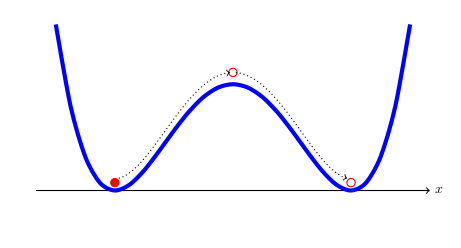Description
The study of Random perturbations of Dynamical Systems draws from both Probability Theory and Dynamical systems.
For example, consider an ordinary differential equation (ODE) driven by the potential \(V:\mathbb{R}^d \to \mathbb{R}\).
\(dX_t = -\nabla V (X_t) dt.\)
A perturbation of this ODE consists of adding to the evolution a Brownian noise with intensity parametrized by \(\varepsilon\) and consider the limit behavior of the systems as \(\varepsilon \to 0\).
\(dX^\varepsilon_t = -\nabla V(X^\varepsilon_t) dt + \varepsilon \sigma(X^\varepsilon_t) dB_t\).
In this set up one considers qualitative properties that can be expected from evolutions that are similar to the given ODE. In this respect, the goals of the analysis of Random Dynamical systems is to compute limit laws (as \(\varepsilon \to 0\) for the family of processes \(\{X^\varepsilon_t, t \geq 0, \varepsilon \geq 0\}\), such as the law of large numbers, the central limit theorem, the large deviation principle and the invariant measures of the system.
For example the addition of noise to a field corresponding to a double-well potential, see figure bellow, allows a particle that would otherwise remain trapped in a local minimum, to exit this region, on rare occasions. In this way, the addition of noise to the system makes the dynamics irreducible, as all regions have a positive probability of being reached.
There is a relationship between the intensity of the noise, the height of the potential and the time that it takes for such a ''Brownian particle'' to escape the local minimum. An interesting question is to describe with precision the expected evolution of such a system in terms of the shape of the potential.
The project will start from the introductions of the books ''Random Perturbations of Dynamical systems'' by Freidlin and Wentzell [1979] and ''Random Dynamical Systems'' by Arnold [1998] and you will have the freedom to investigate topics according to your preferences.
Here is a list with couple of such topics. From the probability side:
- Exit time of random processes from a given domain,
- The averaging principle,
- Differential equations with semimartingale driving proceses.
From a Dynamical systems point of view:
- Multiplicative/subadditive ergodic theory,
- Lyapunov exponents,
- Random bifurcation theory.
Prerequisites
Probability II,
Basic knowledge of Stochastic processes.
